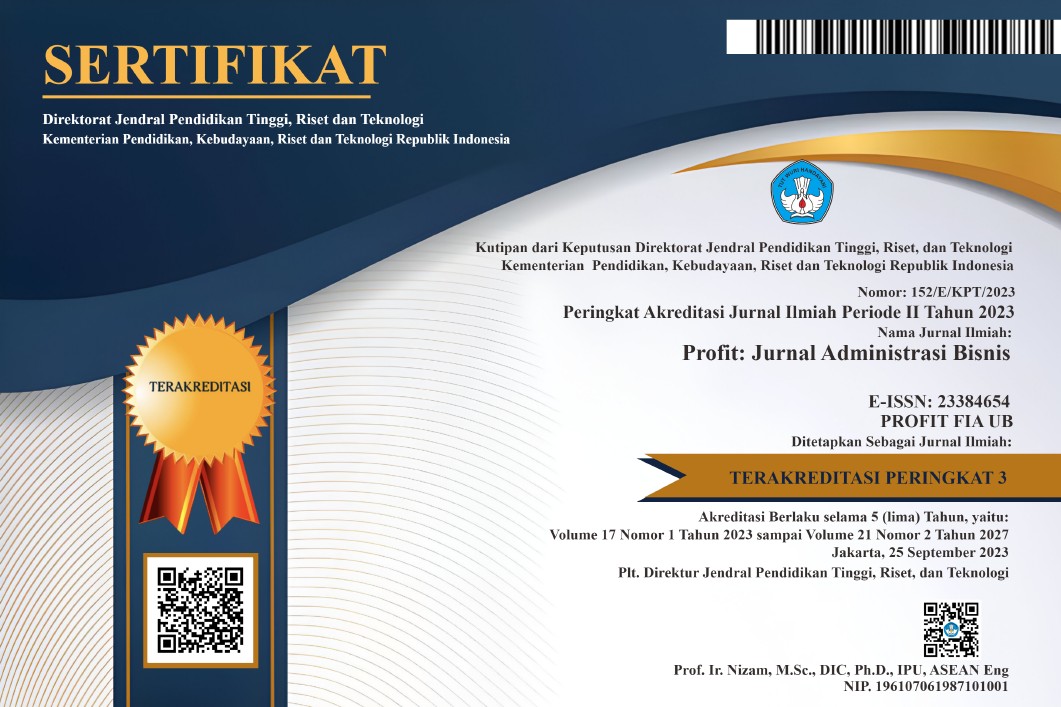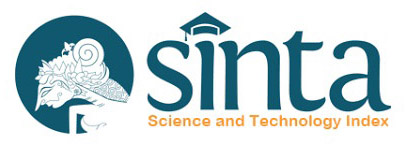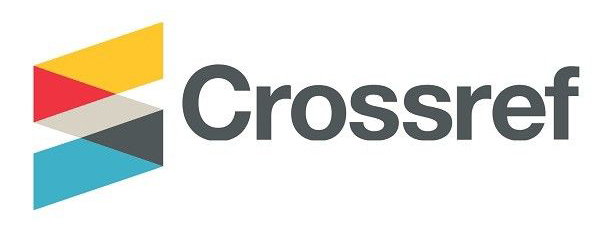The Influence of Corporate Governance and Ownership Structure on Competitive Advantage: An Empirical Study in Indonesian Manufacturing Industry
DOI:
https://doi.org/10.21776/ub.profit.2023.017.01.10Keywords:
Corporate Governance; Ownership Structure; Competitive AdvantageAbstract
Corporate governance describes the governance used to carry out the business activities of a corporation. This study aims to analyze the influence of Corporate Governance and Ownership Structure on Competitive Advantage. The Corporate Governance variable is explained by the size of the board of commissioners, educational background of the chairman of the board of commissioners, size of the board of directors, educational background of the chairman of the board of directors, and experience of the board of Directors. The competitive advantage variable is explained by capital intensity, market share, receivable turnover, cost of sales, and inventory turnover. This type of research is explanatory research because it explains the influence of corporate governance and ownership structure on competitive advantage. The relationship between variables is explained by testing two hypotheses. The sampling method used purposive sampling and obtained a sample of 36 companies, obtained from 12 companies for 3 years. using secondary data, namely the company's annual report. Data analysis in this study used Partial Least Square (PLS) with WarpPLS 7.0 software. The test results in this study indicate that there is a significant influence of corporate governance and ownership structure on competitive advantage.
References
Al-Sartawi, A. M. (2018). Ownership structure and intellectual capital: evidence from the GCC countries. Journal Learning and Intellectual Capital, 15(3), 277-291.
Al-Qatawneh, A. S. (2015). The Impact of Corporate Governance in Achieving Competitive Advantage - A Field Study of Jordanian Pharmaceutical Companies. European Journal of Business and Management, 7(35), 9-17.
Bakemeyer, R. (2007). legitimacy as a Key Driver and Determinant of CSR in Developing Countries. Paper for the 2007 Marie Curie Summer School on Earth System Governance.
Barney, J. (1991). Firm resources and sustained competitive advantage. Journal of Management, 17(1), 99-120.
Bena, Jan., Xu, Ting. (2017). Competition and Ownership Structure of Closely Held Firms. The Review of Financial Studies, 30(5), 1583-1626.
Bruque, S., Moyano, J., Vargas, A., & Hernandez, M. (2003). Ownership Structure, Technological Endowment, and Competitive Advantage: DO Democracy and Business Fit? Technology Analysis & Strategic Management, 15(1), 65-79.
Budiarti, E., & Sulistyowati, C. (2014). Struktur Kepemilikan dan Struktur Dewan Perusahaan. Jurnal Manajemen Teori dan Terapan, 7(3), 161-177.
Camara, S. B., Fuentes, J. M, Ortiz, M. J. H., Sanchez, A. V. (2003).Information Technology and Competitive Advantage. The Role of the Ownership Structure.
Chams, N., & Garcia-Blandon, J. (2019). Sustainable or not sustainable? The role of the board of directors. Journal of Cleaner Production, 226, 1067-1081.
Chang, Y. K., Oh, W., Park, J. H., & Jang, M. G. (2015). Exploring the relationship between board characteristics and CSR: Empirical evidence from Korea. Journal Business Ethics, 140(2), 225-242.
Chari, M., David, P., Duru, A., & Zhao, Y. (2019). Bowman's risk-return paradox: an agency theory perspective. Journal Business Resources, 95, 357-375.
Chong, L.-L., Ong, H.-B., & Tan, S.-H. (2018). Corporate risk-taking and performance in Malaysia: the effect of board composition, political connections, and sustainability practices. Corporate Governance: The International Journal of Business in Society, 18(4), 635-654.
David, F. R. (2013). Strategic Management: Concepts and Cases (Vol. 14 Edition). Pearson Education.
Eisenhardt, K. M. (1989). Agency Theory: An Assessment and Review. Academy of Management Review, 14(1), 57-74.
Febriani, J. I., Musadieq, M. A., & Afrianty, T. W. (2016). Pengaruh Good Corporate Governance Terhadap Kinerja (Studi pada Karyawan PT. Pos Indonesia (Persero) Tuban). Jurnal Administrasi Bisnis, 32(1), 82-89.
Garcia-Torea, N., Fernandez-Feijoo, B., & Cuesta, M. (2016). Board of director's effectiveness and the stakeholder perspective of corporate governance: Do effective boards promote the interests of shareholders and stakeholders? Business Research Quarterly, 19, 246-260.
Hakim, M. F., & Nuzula, N. F. (2018). Pengaruh Corporate Governance dan Struktur Modal terhadap Profitabilitas (Studi pada Perusahaan Perbankan yang Terdaftar di BEI Periode 2012-2016). Jurnal Administrasi Bisnis, 61(1), 191-200.
Hambrick, D. C., & Mason, P. A. (1984). Upper echelons: the organization as a reflection of its top managers. Academy of Management, 9(2), 193-206.
Hamdani. (2016). Good Corporate Governance Tinjauan Etika dalam Praktik Bisnis. Jakarta: Mitra Wacana Media.
Harjoto, M., Laksamana, I., & Lee, R. (2014). Board Diversity and Corporate Social Responsibility. Journal Business Ethics, 132(4), 641-660.
Hasnan, S., Marzuki, H., & Shuhidan, S. (2017). Effects of board characteristics on financial restatement in Malaysia. Pertanika Journal of Social Sciences and Humanities, 25, 259-268.
He, W., & Luo, J.-h. (2018). Agency problems in firms with an even number of directors: Evidence from China. Journal of Banking and Finance, 139-150.
Hitt, M. A., Ireland, R. D., & Hoskisson, R. E. (2012). Strategic Management: Concepts Competitiveness and Globalization (Vol. 10 Edition). Cengage Learning.
Hussain, N., Surti, C., & Searcy, C. (2018). Corporate governance and sustainability performance: analysis of triple bottom line performance. Journal Business Ethics, 149(2), 411-432.
Ismail, A. I., Rose, R., Abdullah, H., & Uli, J. (2010). The relationship between organizational competitive advantage and performance is moderated by the age and size of firms. Asian Academy of Management Journal, 15(2), 157-173.
Jensen, M., & Meckling, W. (1976). Theory of the firm: managerial behavior, agency cost ,and ownership structure. Journal of Financial Economics, 3, 305-360.
Junaedi, A., & Farina, K. (2017). pengaruh Efektivitas Dewan Komisaris dan Komite Audit, Struktur Kepemilikan Perusahaan dan Kualitas Audit Terhadap Perataan Laba. Jurnal Manajemen Bisnis Krisnadwipayana, 5(1), 1-17.
King, L., & Schroeder, H. (2013). Principal Findings, Applications, and Research Frontiers. Institutions and Environmental Change.
Kusuma, D., & Hermuningsih, S. (2011). Pengaruh Struktur Kepemilikan terhadap Nilai Perusahaan Dengan Kinerja Keuangan dan Kebijakan Hutang sebagai Variabel Intervening. Jurnal Siasat Bisnis, 15(1), 27-36.
Lestari, N. P., & Juliarto, A. (2017). Pengaruh Dimensi Struktur Kepemilikan Terhadap Kinerja Perusahaan Manufaktur. Diponegoro Journal of Accounting, 6(3), 1-10.
Madhani, P. M. (2014). Corporate Governance from Compliance Competitive Advantage. The Accounting World, 7(8), 26-31.
Munisi, Gibson, & dkk. (2014). Corporate Boards and Ownership Structure: Evidence from Sub-Saharan Africa. Jurnal Bisnis Internasional, 23(1), 785-796.
Mulyono, Manurung, A., Alamsjah, F., & Hamsal, M. (2020). The Effect of Corporate Governance, E-Business and Innovation on Competitive Advantage and Implication on Financial Performance. Pertanika J. Soc. Sci. & Hum., 28(1), 1-13.
Nugroho, P. A. (2017). Pengaruh Struktur Kepemilikan Manajerial, Struktur Kepemilikan Institusional, Set Kesempatan Investasi, Ukuran Perusahaan terhadap Nilai Perusahaan. Jurnal Ekonomi dan Bisnis Airlangga, 27(1).
Oh, W. Y., Chang, Y. C., & Jung, R. (2019). Board Characteristics and Corporate Social Responsibility: Does family involvement in management matter? Journal Business resource, 103, 23-33.
Otungu, O. A., Nyongesa, W., Ochieng, O., & Simeon, K. (2011). Strategic Management: The Link Between The Agency Theory and The Company's Competitive Advantage. International Journal of Business and Social Science, 2(23), 232-237.
Panda, B., & Leepsa, N. M. (2017). Agency theory: Review of Theory and Evidence on Problems and Perspective. Indian Journal of Corporate Governance, 10(1), 74-95.
Papadimitri, P., Pasiouras, F., Tasiou, M., & Ventouri, A. (2020). The effects of the board of directors’ education on firms credit ratings. Journal Business Resource, 116, 294-313.
Porter, M. (1980). Competitive Strategy: Techniques for Analyzing Industries and Competitors. New York: NY: The Free Press.
Primadasa, D. G., & Muharam, H. (2015). Analisis Faktor-Faktor yang Mepengaruhi Dividend Payout Ratio pada Perusahaan Manufaktur yang Listed di BEI Tahun 2008-2012. DIponegoro Journal of Management, 4(2), 1-15.
Rossignoli, F., Lionzo, A., & Buchetti, B. (2020). beyond corporate governance reporting: the usefulness of information on board member profiles. Journal of Management and Governance.
Saidu, S. (2019). CEO characteristics and firm performance: focus on origin, education and ownership. Journal of Global Entrepreneurship Research, 9(1).
Saifi, M. (2019). Pengaruh Corporate Governance dan Struktur Kepemilikan terhadap Kinerja Keuangan Perusahaan. Jurnal Profit, 13(2), 1-11.
Sarafina, S., & Saifi, M. (2017). Pengaruh Good Corporate Governance Terhadap Kinerja Keuangan dan Nilai perusahaan (Studi pada BUMN yang terdaftar di BEI Periode 2012-2015). Jurnal Administrasi Bisnis, 50(2), 108-117.
Siregar, S. (2014). Metode Penelitian Kuantitatif Dilengkapi Dengan Perbandingan Perhitungan Manual dan SPSS. Jakarta: Kencana.
Syafitri, T., Nuzula, N. F., & Nurlaily, F. (2018). Pengaruh Good Corporate Governance terhadap Nilai Perusahaan (Studi pada Perusahaan Industri Sub Sektor Logam dan Sejenisnya yang Terdaftar di BEI Periode 2012-2016). Jurnal Administrasi Bisnis, 56(1), 118-126.
Teece, D. (2019). A capability theory of the firm: an economics and (strategic) management perspective. New Zealand Economic Paper, 53, 1-43.
Ullah, H., A., F., & S., K. (2012). The Impact of Ownership Structure on Dividend Policy Evidence from Emerging Markets KSE-100 Index Pakistan. International Journal of Business and Social Science, 3(9), 298-307.
Vitolla, F., Raimo, N., & Rubino, M. (2020). Board characteristics and integrated reporting quality: an agency theory perspective. Corporate Social Responsibility Environment Management, 27(2), 1152-1163.
Wu, S., Quan, X., Xu, L. (2011). CEO power, disclosure quality and the variability of firm performance. Nankai Business Review International, 2(1), 79-97.
Wulandari, T. R., & Setiawan, D. (2021). Ownership concentration, foreign ownership and tunneling in Indonesia. Rajagiri Management Journal.
Zahid, M., Rahman , H., Ali, W., Khan, M., Alharthi, M., Qureshi, M. I., & Jan, A. (2020). Boardroom gender diversity: implications for corporate sustainability performance. Journal of Cleaner Production, 244.
Zaid, M. A., Wang, M., Adib, M., Sahyouni, A., & Abuhijleh, S. T. (2020). Boardroom nationality and gender diversity: implications for corporate sustainability performance. Journal of Cleaner Production, 251, 119652.
Downloads
Published
Issue
Section
License
Copyright (c) 2023 PROFIT: JURNAL ADMINISTRASI BISNIS

This work is licensed under a Creative Commons Attribution-NonCommercial 4.0 International License.
The copyright of the received article shall be assigned to the journal as the publisher of the journal. The intended copyright includes the right to publish the article in various forms (including reprints). The journal maintains the publishing rights to the published articles.

This work is licensed under a
Creative Commons Attribution-NonCommercial 4.0 International License

















